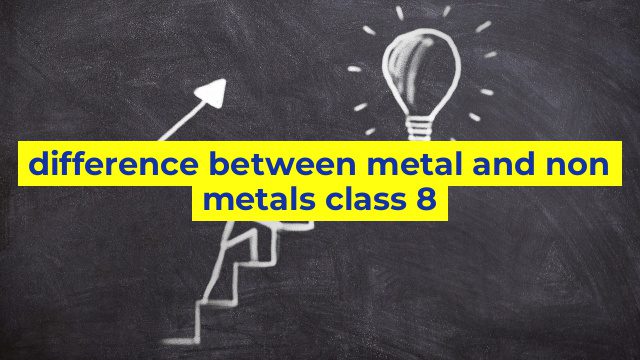The Basic Difference Between Metal and Non-Metals in Class 8 Chemistry
Metal and Non-Metal are two distinct elements that have a significant role in chemistry. Both of them possess some unique properties that set them apart from each other. In Class 8 chemistry, students are introduced to the fundamental difference between metals and non-metals. Here we will discuss some crucial differences between them.
Nature
The very basic difference between metals and non-metals lies in their nature. Metals are conductive elements and are known for their shiny, lustrous appearance. On the other hand, non-metals are non-conductive elements with a dull appearance.
Physical Properties
Metal elements have high melting and boiling points, whereas non-metal elements have generally low melting and boiling points. Metals are malleable and ductile, meaning that they can be hammered into thin sheets and drawn into thin wires. Non-metals, in contrast, are brittle and cannot be flattened or drawn like metals.
Chemical Properties
Metals are known to be highly reactive elements and can easily lose electrons to form positive ions. They react with non-metals to form ionic bonds. On the other hand, non-metals tend to gain electrons and tend to form negative ions. They react with metals to form covalent bonds.
Usage
Metals have a wide range of uses in our daily life. They are used in making buildings and infrastructure, electric wires, vehicles, and many other household items. Non-metals, on the other hand, are mostly used in the manufacturing of non-metallic materials like plastics, medicines, and fertilizers.
Conclusion
In conclusion, the difference between metal and non-metal is quite apparent. The nature, physical and chemical properties, and usage of both metals and non-metals are different. Understanding these differences is essential for students of Class 8 chemistry, as it will help them understand the various applications of these elements in our daily lives.
Table difference between metal and non metals class 8
| Category | Metal | Non-metal |
|---|---|---|
| Electrical Conductivity | Good conductor of electricity | Poor conductor of electricity |
| Heat Conductivity | Good conductor of heat | Poor conductor of heat |
| Appearance | Shiny, metallic | Dull, non-metallic |
| Malleability | Malleable, can be hammered into thin sheets | Brittle, cannot be hammered into thin sheets |
| Ductility | Ductile, can be drawn into wires | Non-ductile, cannot be drawn into wires |
| Chemical Reactivity | Reacts with acids to form salt and hydrogen gas | May react with other non-metals to form compounds |

